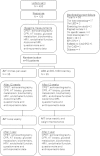Copenhagen study of overweight patients with coronary artery disease undergoing low energy diet or interval training: the randomized CUT-IT trial protocol
- PMID: 24252596
- PMCID: PMC4225526
- DOI: 10.1186/1471-2261-13-106
Copenhagen study of overweight patients with coronary artery disease undergoing low energy diet or interval training: the randomized CUT-IT trial protocol
Abstract
Background: Coronary artery disease (CAD) is accountable for more than 7 million deaths each year according to the World Health Organization (WHO). In a European population 80% of patients diagnosed with CAD are overweight and 31% are obese. Physical inactivity and overweight are major risk factors in CAD, thus central strategies in secondary prevention are increased physical activity and weight loss.
Methods/design: In a randomized controlled trial 70 participants with stable CAD, age 45-75, body mass index 28-40 kg/m2 and no diabetes are randomized (1:1) to 12 weeks of intensive exercise or weight loss both succeeded by a 40-week follow-up. The exercise protocol consist of supervised aerobic interval training (AIT) at 85-90% of VO2peak 3 times weekly for 12 weeks followed by supervised AIT twice weekly for 40 weeks. In the weight loss arm dieticians instruct the participants in a low energy diet (800-1000 kcal/day) for 12 weeks, followed by 40 weeks of weight maintenance combined with supervised AIT twice weekly. The primary endpoint of the study is change in coronary flow reserve after the first 12 weeks' intervention. Secondary endpoints include cardiovascular, metabolic, inflammatory and anthropometric measures.
Discussion: The study will compare the short and long-term effects of a protocol consisting of AIT alone or a rapid weight loss followed by AIT. Additionally, it will provide new insight in mechanisms behind the benefits of exercise and weight loss. We wish to contribute to the creation of effective secondary prevention and sustainable rehabilitation strategies in the large population of overweight and obese patients diagnosed with CAD.
Trial registration: ClinicalTrials.gov: NCT01724567.
References
-
- Mendis S, Puska P, Norrving B, editor. Global atlas on cardiovascular disease prevention and control. Geneva: World Health Organization; 2011.
-
- Perk J, De BG, Gohlke H, Graham I, Reiner Z, Verschuren WM. et al.European guidelines on cardiovascular disease prevention in clinical practice (Version 2012): the Fifth Joint Task Force of the European Society of Cardiology and Other Societies on Cardiovascular Disease Prevention in Clinical Practice (Constituted by Representatives of Nine Societies and by Invited Experts) Int J Behav Med. 2012;19:403–488. doi: 10.1007/s12529-012-9242-5. - DOI - PubMed
-
- Rognmo O, Hetland E, Helgerud J, Hoff J, Slordahl SA. High intensity aerobic interval exercise is superior to moderate intensity exercise for increasing aerobic capacity in patients with coronary artery disease. Eur J Cardiovasc Prev Rehabil. 2004;11:216–222. doi: 10.1097/01.hjr.0000131677.96762.0c. - DOI - PubMed
Publication types
MeSH terms
Associated data
LinkOut - more resources
Full Text Sources
Other Literature Sources
Medical
Miscellaneous


